![]()
![]()
![]()
Use LEFT and RIGHT arrow keys to navigate between flashcards;
Use UP and DOWN arrow keys to flip the card;
H to show hint;
A reads text to speech;
334 Cards in this Set
- Front
- Back
- 3rd side (hint)
|
Impact of air pollution on plant |
Abscission, necrosis, chlorosis |
|
|
|
Spacing b/w 2 bars in medium size screens |
20-40mm |
|
|
|
Law applicable to explain sedimentation |
Stoke's law Hazen's law Newton's law |
|
|
|
Tularemia disease is due to |
Bacteria |
|
|
|
Water present in artesian aquifer is |
Above atmospheric pressure |
|
|
|
Peak factor of population from 50000 to 2 lakhs |
2.5 |
|
|
|
Treatment economically effective in the control of guinea worm disease |
Filtration |
|
|
|
Predominating coagulation mechanism for raw water having high turbidity and high alkalinity |
Sweep coagulation |
|
|
|
Usual size of residential ferrule bore varies from |
10mm to 50mm |
|
|
|
Self purification of running streams may be due to |
Dilution, sedimentation & oxidation |
|
|
|
Sewage may be disposed off without treatment into water body if the available dilution is |
More than 500 |
|
|
|
To divert excessive flow from combined sewers, the most commonly used weir is |
Leaping weir |
|
|
|
Detention period of oxidation pond |
10-15 days |
|
|
|
Laying of sewer is usually done with the help of |
Sight rails & boning rods |
|
|
|
Design discharge for combined sewer |
Rainfall + 2DWF |
|
|
|
Specific gravity of sewage |
Slightly more than 1 |
|
|
|
Velocity of does not depends on |
Length of drain |
|
|
|
Scour valve are provided at |
At every depression and dead ends To drain out waste water that may collect there |
|
|
|
Manholes are less common in |
Cast iron pipe |
|
|
|
A pressure conduit carrying water beneath a stream or a canal |
Inverted siphon (or) sag (or) depressed pipe |
|
|
|
Components of domestic water demand |
Drinking - 5 litre Cooking - 5 litre Bathing - 55 litre Cloth washing -20 litre Utensil washing - 10 litre House washing -10 litre Flushing of water closet - 30 litre |
|
|
|
Distribution system in water supplies is designed on the basis of |
Total water demand |
|
|
|
Colour, odour, pH value, taste, turbidity, total dissolved solid acceptable and permissible limit |
Colour, Hazen unit Acceptable limit - 5 Permissible limit in the absence of alternate source- 15 Method of test - IS 3025 part 4 Method of test : part 5 PH value Acceptable limit : 6.5 -8. 5 Method of test - part 11 Taste Method of test: parts 7&8 Turbidity, NTU OdourMethod of test : part 5PH valueAcceptable limit : 6.5 -8. 5Method of test - part 11TasteMethod of test: parts 7&8Turbidity, NTUAcceptable limit - 1Permissible -5Method of taste: part 10Total dissolved solid, mg/LPermissible :500Acceptable: 2000Method of test : Part 16 Acceptable limit - 1 Permissible -5 Method of taste: part 10 Total dissolved solid, mg/L Permissible :500 Acceptable: 2000 Method of test : Part 16 |
|
|
|
Aluminium permissible and acceptable limit |
Aluminium acceptable- 0.03 mg/L Permissible - 0.2mg/L Ammonia acceptable - 0.5 Anionic detergent acceptable - 0.2 Permissible - 1.0 Barium acceptable -0. 7 Boron acceptable - 0.5 Permissible - 1. 0 acceptable -75 Permissible - 200 acceptable - 4 Chloride acceptable - 250 Permissible -1000 Flouride acceptable -1 Permissible -1. 5 Copper acceptable - 0. 05 Permissible - 1.5 Free residual chlorine acceptable - 0.2 Permissible - 1 Iron acceptable - 0. 3 Magnesium acceptable - 30 Permissible - 100 acceptable - 0.1 Permissible - 0.3 Calcium acceptable -75 Permissible - 200Chloramines acceptable - 4Chloride acceptable - 250Permissible -1000Flouride acceptable -1Permissible -1. 5Copper acceptable - 0.05Permissible - 1.5Free residual chlorine acceptable - 0.2Permissible - 1Iron acceptable - 0. 3Magnesium acceptable - 30Permissible - 100Manganese acceptable - 0.1Permissible - 0.3Mineral oil acceptable - 0.5Nitrate acceptable - 45Phenolic compound acceptable - 0.001Permissible - 0.002Selenium acceptable - 0.01Silver acceptable - 0.1Sulphide acceptable 0.05Sulphate acceptable - 200Permissible - 400Total alkalinity acceptable - 200Permissible - 600Total hardness acceptable - 200Permissible - 600Zinc acceptable - 5Permissible - 15 Mineral oil acceptable - 0.5 Chloramines acceptable - 4Chloride acceptable - 250Permissible -1000Flouride acceptable -1Permissible -1. 5Copper acceptable - 0.05Permissible - 1.5Free residual chlorine acceptable - 0.2Permissible - 1Iron acceptable - 0. 3Magnesium acceptable - 30Permissible - 100Manganese acceptable - 0.1Permissible - 0.3Mineral oil acceptable - 0.5Nitrate acceptable - 45Phenolic compound acceptable - 0.001Permissible - 0.002Selenium acceptable - 0.01Silver acceptable - 0.1Sulphide acceptable 0.05Sulphate acceptable - 200Permissible - 400Total alkalinity acceptable - 200Permissible - 600Total hardness acceptable - 200Permissible - 600Zinc acceptable - 5Permissible - 15 Nitrate acceptable - 45 Phenolic compound acceptable - 0.001 Permissible - 0.002 Selenium acceptable - 0.01 Silver acceptable - 0.1 Manganese acceptable - 0.1Permissible - 0.3Mineral oil acceptable - 0.5Nitrate acceptable - 45Phenolic compound acceptable - 0.001Permissible - 0.002Selenium acceptable - 0.01Silver acceptable - 0.1Sulphide acceptable 0.05Sulphate acceptable - 200Permissible - 400Total alkalinity acceptable - 200Permissible - 600Total hardness acceptable - 200Permissible - 600Zinc acceptable - 5Permissible - 15 Sulphide acceptable 0.05 Sulphate acceptable - 200 Permissible - 400 Total alkalinity acceptable - 200 Permissible - 600 Total hardness acceptable - 200 Permissible - 600 Zinc acceptable - 5 Permissible - 15 |
|
|
|
Total concentratn of iron & manganese shall not exceed |
0.3 mg/L |
|
|
|
Free residual chlorine concentration when protection against viral infection is required |
Minimum 0.5 mg/L |
|
|
|
Toxic substance permissible and acceptable limits in drinking water |
Cadmium acceptable - 0.003
Cyanide acceptable - 0.05
Lead acceptable - 0. 01
Mercury acceptable - 0.001
Nickel acceptable -0. 02
Arsenic acceptable - 0.01 Permissible - 0.05
Chromium acceptable - 0.05
Chloroform acceptable - 0.2 |
|
|
|
Decrease in radius of cyclone collector |
Increase the efficiency Cyclone collector is used to separate particle from gas stream using centrifugal force. Fc = Mp*Vi^2/R Mp - mass of particle Vi - inlet velocity R - radius of cyclone |
|
|
|
Air pollutants responsible for acid rain |
Sulphur dioxide and oxides of nitrogen. 2/3 SO2 and 1/3 oxides of nitrogen
Acid rain - PH <5.6 |
|
|
|
Radioactive substances |
Alpha emitters (Bq/L) acceptable - 0.1 Method to test - IS 14194 part 2 Beta emitters acceptable -1 Method to test - part 1 |
|
|
|
Bacteriological quality of drinking water |
1. E-coli Or Thermotolerant coliform bacteria 2. Total coliform bacteria Shall not be detectable in any 100ml sample |
|
|
|
Temperature variation in troposphere and stratosphere |
Temperature decreases with altitude in troposphere & mesosphere.
Temperature increases with altitude in stratosphere & ionosphere.
Ozone layer is present in stratosphere. |
|
|
|
Purpose of proportional weir at the effluent end of a channel type grit removal unit |
Grit chamber - used to remove inorganic grit of d>2mm and G>2.65 - Parshall flume or proportional weir is used to maintain constant flow velocity (0.3m/s) |
|
|
|
Where does sloughing occur |
Trickling filter |
|
|
|
Characteristics of fresh sewage and septic sewage |
Fresh sewage - alkaline Septic sewage - acidic |
|
|
|
PH in chlorination |
PH <5 - elemental chlorine PH>10 - 100% hypochorite ion 5<PH>7 - 100% HOCl |
|
|
|
Connection from main pipe to house connection |
Ferrule - goose neck pipe - stop cock - water meter |
|
|
|
Gully trap is provided |
Trap : To prevent foul gases from coming out of soil pipe/waste pipe. Gully trap : junction of roof drain, and other drain from kitchen or bathroom Intercepting trap: at the juction of house sewer and municipal sewer . Disconnect house sewer from street sewer. Floor trap / Nahani trap : used to admitt sludge from floor of room, bathroom, kitchen |
|
|
|
Best material for the pipes to be laid under water |
Cement concrete -do not corrode - life of 75 years Cast iron pipes -widely used in city water supply - life of 100 years -now replaced by ductile iron pipe |
|
|
|
Pipe joints commonly used in pumping station |
Flanged joints used in pumping station, filter plants where it may be necessary to disjoint pipe. Strong but rigid Not suitable where deflection or vibrations are expected |
|
|
|
Free chlorine to inactivate virus |
>0.5 mg/L of free chlorine for 1 h is sufficient |
|
|
|
Amoebiasis |
Can't be removed by chlorination Can be removed by filtration |
|
|
|
Dracontiasis Or Guinea-worm disease |
Due to Dracunculus medinensis |
|
|
|
IS code for method of sampling and microbiological examination of water |
IS 1622:1981 |
|
|
|
IS code for methods of sampling and test (Physical and chemical) for water & waste water |
IS 3025 |
|
|
|
For communities with population up to 20,000 and without system |
Water supply Min 40lpcd for standpost 70-100 lpcd for house service connection |
|
|
|
Water supply For communities with population 20,000 - 1 lakh with full flushing system |
100-150 lpcd |
|
|
|
Water supply for communities with population above 1 lakh with full flushing system |
150-200 lpcd |
|
|
|
Water requirements for building other than residences |
1. Factories with bathroom - 45 lpcd 2.Factories without bathroom - 30 lpcd 3. Hospital upto 100 beds - 340 lpcd 4. Hospital with more than 100 beds - 450 lpcd 5. Nurses home & medical quarters -135 lpcd 6. Hostel - 135 lpcd 7. Hotel - 180 lpcd 8. Offices - 45 lpcd 9. Restaurant -70 per seat 10. Cinemas, concert hall, theatres - 15 per seat 11. Day school - 45 lpcd 12.Boarding school - 135 lpcd |
|
|
|
Water demand for railway, bus station and sea ports |
1. Intermediate stations (excluding mail and express stops) Bathing facilities provided - 45 lpcd Without bathing facility - 25 lpcd 2. Junction station and intermediate station where mail Or express stop Batching facility -70 lpcd Without batching - 45 lpcd 3. Terminal station - 45 lpcd 4. Airport - 70 lpcd |
|
|
|
Which industry require max water demand |
Paper industry (200-400) per kilolitres of raw material |
|
|
|
Water demand split up |
Domestic - 135 lpcd (50-60%) Industrial - 50 lpcd (20-25%) Institutional and commercial - 20 lpcd Public use - 10 (5-10%) Losses and theft - 55 (10-15%) Total - 270 lpcd without full flushing system 335 lpcd with full flushing system |
|
|
|
Domestic water demand split up |
Low income group Drinking - 5 Cooking - 5 Bathing -55 Washing cloth -20 Washing utensils -10 Cleaning house -10 Flushing -30 Total - 135 High income group Cooking - 5 Drinking - 5 Bathing - 75 Washing cloth -25 Washing utensils -15 Cleaning house - 15 Flushing - 45 Gardening - 15 Total - 200 |
|
|
|
Filter paper for determination of suspended solids |
Whatsmann filter paper NO:44 |
|
|
|
To find inorganic or fixed solids or non-volatile solids |
Muffle furnace |
|
|
|
Sour taste & bitter taste |
PH<4 sour taste PH>4 bitter taste |
|
|
|
Working range of methyl orange and phenolphthalein in PH |
Methyl orange - 3.1 to 4.4 (Pink to yellow) Phenolphthalein - 8.6 to 10.3 ( yellow to pink) |
|
|
|
Measurement of acidity |
Titrant - NaOH |
|
|
|
Working range of alkalinity |
Bicarbonate alkalinity - PH 7 to 8.2 Carbonate alkalinity - PH 8.2 to 10.2 Hydroxyl alkalinity - PH 10.2 to 14 |
|
|
|
Alkalinity measurenent |
Titrant - Diluted sulphuric acid (0.02N) Indicator: Methyl orange M or T alkalinity(yellow to pink) Phenolphthalein P alkalinity (pink to colourness) |
|
|
|
Hardness |
Due to multivalent metallic cations such as Ca, Mg, Al, Fe
Carbonate hardness (Temperory haedness) - removed by boiling and lime addition
Non carbonate Or permanent hardess - removed by lime soda process, ionization method, zeolite method |
|
|
|
Hardness estimation |
Versanate method /EDTA method Indicator : Erichrome Black-T (wine red to blue) |
|
|
|
Amount of Calcium hydroxide required for the removal of MgCO3 and Mg(HCO3)2 |
1 mole of calcium hydroxide reqd for removal of 1 mole of MgCO3 2 mole of calcium hydroxide reqd for the removal of 1 mole of Mg bicarbonate |
|
|
|
Hardness is also expressed in degree of hardness |
Clark's scale = 14.25 ppm of CaCO3 1 clark's scale = 1 British degree of hardness One French scale = 1french degree of hardness = 10 ppm of CaCO3 One american degree of hardness = 17.15 ppm of CaCO3 |
|
|
|
Boiler feed water hardness |
less than 75 ppm |
|
|
|
Chloride determination |
Mohr's method or argentometric titration Titrant : silver nitrate Indicator : Potassium chromate |
|
|
|
Sulphate determination |
Turbidimetric method using barium as barium sulphate Causes laxative pblm and diarrhea |
|
|
|
Dissolved oxygen |
- To know the extent of pollution of water - absence of DO - water to be septic High amount of DO - corrosion Wrinklers method Titrant - sodium thio sulphate Indicator - starch |
|
|
|
Flouride |
Less than 1 ppm - dental cavities More than 1.5 - molting of teeth, flourosis |
|
|
|
Nitrogen compound |
1.Free ammonia - recent pollution - undecomposed organic matter & first stage of decomposition - permissible limit - 0.15 mg/L - acceptable limit - 0.3 mg/L
2.Organic ammonia(albuminoid) - decomposition has started - permissible limit -0.3 mg/L - acceptable limit - 0.45 mg/L
|
|
|
|
Aerobic bacteria |
End products are carbonate and NO3- End pdcts are highly stable Take 3 times less time for decomposition |
|
|
|
Anaerobic bacteria |
End products are acid, alcohol, gases lik H2S, methane &Co2 |
|
|
|
Bacteria based on shape |
Bacilli - rod shaped Cocci - spherical shaped Sprilla - spiral shaped Vibrio - comma shaped |
|
|
|
Ecoli |
Gram negative, rod shaped facultative bacteria |
|
|
|
Testing of pathogen |
1.Qualitative test To check whether organism are present a. Total count test Or agar plate count test B. Membrane filter technique 1.Quantitative test a. MPN b. E-Coli index |
|
|
|
Membrane filter technique |
Nutrient - M-endo medium Inhibits growth of bacteria other than ecoli Time -20 hr Temp - 35°C |
|
|
|
E coli tet also known as |
Multiple tube fermentation test 3 stage 1.Presumptive 2.conformatory 3.completed |
|
|
|
Conformatory test |
Take positive tube Add BGLB - brilliant green lactose broth incubated at 35°C for 24-48 hrs. If gas formed or CO2 present, then confirmed |
|
|
|
MPN |
Bacterial density in water which is likely to be present for the given test result. |
|
|
|
Unit process and unit operation |
Unit operation Removal of pollutants with physical forces Eg : sedimentation Unit process Removal of pollution with With chemical and biological forces Eg: coagulation |
|
|
|
Methods of treatment |
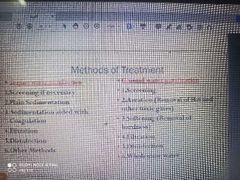
|
|
|
|
Screening |
Velocity through screen = 0.8 - 1 m/s Hed loss through screen = (K/2g) *(v^2 -u^2) K/2g = 0.0729 v - velocity through screen u - velocity of approach |
|
|
|
Function of different treatment process |
Plain sedimention - Removal of suspended solids Sedimentation aided with coagulation - Removal of colloidal particles Filteration - Removal of dissolved solids Disinfection - Removal of pathogen |
|
|
|
Plain sedimention |
1st unit operation Type 1 settling - Discrete particle Remove 70% of suspended impurities Remove particle by controlling flow velocity and flow turbulence |
|
|
|
Type of sedimentation tank |
Intermittent tank Also known as quiscent type Detention time = 24 hr Cleaning time= 8 -12 hrs Fill and draw type Continuous tank Horizontal flow type ST (rectangular shape) L=2B Velocity =0.3m/s Vertical flow type ST (Circular shape) |
|
|
|
Settling velocity |
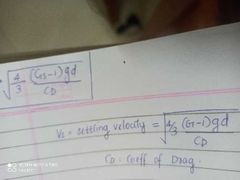
|
|
|
|
Stokes law |
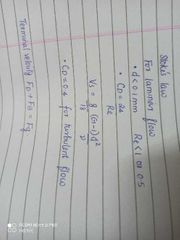
|
|
|
|
Hazen eqn settling velocity |
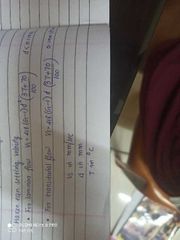
|
|
|
|
Newtons formula |
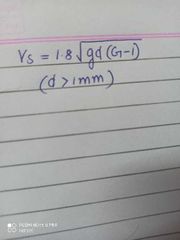
|
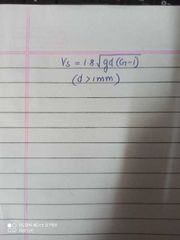
|
|
|
Surface overflow rate or hydraulic overflow rate or hydraulic loading rate or surface loading rate or superficial velocity or frictitious velocity, Vo |
Vo= Q/Surface area |
|
|
|
Detention time |
Avg time taken for particle to travel from inlet to outlet |
|
|
|
Surface overflow rate Vo |
Vo = 500 - 750 L/hr/m2 Vo= 12- 18 m3/day/m2 = 20 m3/day/m2 Vs>Vo , particle wil settle Vs< Vo, particle won't settle |
|
|
|
Flow through velocity |
VH = Q/ Cross sectional area In the range of 0.2 -0. 9m/min (0.3m/min) Width of tank= 10-12m |
|
|
|
Sedimentation efficiency |
Vs/Vo |
|
|
|
Flow though period |
Actual time taken by water to pass from inlet to outlet Flow through period < DT : short circuiting |
|
|
|
Displacement efficiency |
Flow through period /DT Generally 0.25-0.5 L should not exceed 4B Provision for sludge storage = 0.8-1.2m |
|
|
|
Coagulation |
To capture particle d<50micron meter Colloidal stability is measured in term of Zeta potential Mechanism of colloidal destabilizatiin 1. Compression of electon double layer 2. Adsorption and charge neutralisation 3. Sweep coagulation 4. Inter particle bridging Both zeta potential & vander wall force decreases with increase in distance b/w particle. |
|
|
|
Mechanism of colloidal destablisation |
Ionic layer compression: +ve charged ion attracted to colloidal surface Adsorption & charge neutralisation: Metallic ions adsorbed on the surface of colloid. Sweep coagulation: Colloids entrapped on aluminium hydroxide due to gelatinous nature and they are sweep away. Inter particle bridging : Several colloids attached to large molecule of aluminuim Or Fe |
|
|
|
Sedimentation tank (clarifier) |
Type II settling tank Coagulation -DLVO theory Coagulation is adopted when turbidity of water exceeds about 40 ppm. |
|
|
|
Coagulants |
1. Alum Al2 (SO4)3. 18H2O 2. Copperas FeSO4. 7H2O 3. Chlorinated copperas Fe2(SO4)3. FeCl3 3. Sodium aluminate Na2 Al2 O4 |
|
|
|
Alum |
PH range: 6.5 to 8.5 Also need alkalinity of water Alum+ calcium bicarbonate ----> Calcium sulphate+ aluminium hydroxide + water+CO2 If alkalinity is not present, external alkaline agents like lime Ca(OH)2 or soda ash Na2CO3 is added. When lime is added, acidity is not induced but hardness is induced When soda ash is added, acidity is not induced but hardness is not induced Dose of alum : 10-30 mg/L |
|
|
|
Alum dosage |
1 mg/L of alum dosage require 0.45 mg/L of alkalinity in the form of CaCO3. 1 mg/L of alkalinity in the form of CaCO3 require an addition of 0.56mg/L of quick lime. Average dose for normal value = 14 mg/L |
|
|
|
Jar test |
1. Rapid mixing/Flash mixing 100-150 rpm 1-3 minutes Optimum dosage is selected for lowest residual turbidity. Optimum PH=6.3 |
|
|
|
Copperas or hydrated copperas |
Copperas+ calcium bicarbonate Used for sewage treatment pH > 8.5 |
|
|
|
Chlorinated copperas |
Remove colour PH<6.5 & pH >8.5 |
|
|
|
Sodium aluminate |
PH independent Used in boilers and for experimental purpose. |
|
|
|
Lime - Coagulant |
Work above pH 9.5 For the removal of ammonia and phosphorus |
|
|
|
Clariflocculation |
1. Coagulation: Rapid mixing unit - Fast mixing 2. Flocculation : slow mixing unit 3. Sedimentation : settling unit |
|
|
|
Rapid mixing or flash mixing |
Mechanical mixing unit DT= 1 to 3 min Velocity gradient G = 700 - 900 per second |
|
|
|
Flocculator |
Depth of floc chamber = half the depth of settling chamber
Depth = 2 to 4 m G = (v1-v2) /X Power required = G^2 miu V V= volume G = (P/miu.V) ^1/2 G= 10-75 per sec or 20-80 per sec |
|
|
|
Flocculation |
Gt= conjugate opportunity t= time of contact Large value of G & small value of t: dense and small flocc. Horizontal velocity = 0.2-0.8m/s DT= 10-30min Area of paddle = 10-25% total area |
|
|
|
Sedimentation tank in coagulation |
Type 2 settling - flocculent particle DT = 2 to 4 hr SOR = 1000- 1250L/hr/m2 or 20-30 m3/day/m2 |
|
|
|
Method of filtration |
1.Mechanical straining 2. Sedimentation & adsorption 3. Biological metabolism 4. Electrolytic action |
|
|
|
Slow sand filter |
ROF = 100-200 lit/hr/m2 Effective size : 0.2-0.35mm Cu: 1.8-3 Cleaning period : 1-3 months Efficiency = 98-99% Not used for water having turbidity > 50 NTU
Plan area: 100- 2000m2 Thickness of fliter media = 90-110cm Initial head loss = 10-15cm Cleaning when head loss reaches = 0.7-1.2m |
|
|
|
RSF |
Water for backwashing = 2 to 5% Cleaning period = 24 to 48 hour A in plan = 10-50 m2 d10 = 0.35 -5 Cu= 1.2 to 1.8 ROB> ROF Vb< Vs Thickness of fliter media = 30-75cm Cleaning when head loss reaches = 3 m head loss or turbidity reaches to 2.5 NTU |
|
|
|
Disinfection by UV rays |
UV rays of 250-260nm have high germicidal power Used in swimming pools, hospital Destroying protoplasm Can work at a depth of 10cm from surface No residual effect ln (Nt/No) = kIt K= rate of constant
|
|
|
|
Disinfection by adding lime |
PH of water increases PH>9.5, no pathogens wil survive Some residual power Recarbonation is required |
|
|
|
Disinfection using metal ion |
Silver, copper Silver is more powerful than copper |
|
|
|
Disinfection by KMnO4 |
Cheapest Need at least 24 hours Widely used in disinfecting wells in rural areas Normal dose = 1 to 2 mg/L with a contact period of 4-6 hrs 100% removal of vibrio cholera Remove bad smell and taste |
|
|
|
Disinfection by ozone |
Also called ionisation Instantly destroy microbes Improve colour, odour, taste Remove volatile organic substance No 2° pblm No residual effect For generating 10 kg of ozone, 0.82KWh electricity is required. |
|
|
|
Disinfection by halogen group |
Bromine & iodine Used for army troops, swimming pools |
|
|
|
Disinfection by chlorine |
Very high residual power Free available chlorine = HOCl and OCl- HoCl : ph increases, efficiency decrease s Metal ions: con. Of metal ion increases, efficiency increases Turbidity : tur increases, Effie decreases PH: ph increases, efficiency decrease sMetal ions: con. Of metal ion increases, efficiency increasesTurbidity : tur increases, Effie decreasesAmmonia: similar to turbidityTemperature : temp increases, efficiency increasesContact time: similar to temp Ammonia: similar to turbidity Temperature : temp increases, efficiency increases Contact time: similar to temp |
|
|
|
Effect of PH in chlorination |
PH>9.5 = 100% 0Cl- PH : 7.5-9.5 both HOCl & OCL- pH=7.5 : 50% each PH = 5.5-7.5 : 100% HOCl |
|
|
|
Chloramines |
Combined chlorine 1.mono chloramine - pH >8.4 2. Dichloramines : pH = 4.4 to 5.4 3.trichloramines: pH < 4.4 |
|
|
|
Chlorine dosage, residual chlorine |
Chlorine dosage = 0.3 - 1.1 mg/L Residual chlorine : 0.1-0.2 mg/L |
|
|
|
Chlorine gas or liquid chlorine |
Optimum temp : 32-48°C Can not used in water where phenols present |
|
|
|
Hypochlorite |
Calcium hypochlorite or bleaching powder : 30-35% cl2 Sodium hypochlorite : 10-15% cl2 |
|
|
|
Chlorine dioxide, chloramines |
Chlorine dioxide 2.5 times more power than free chlorine No residual power chloramines Used when phenols is present in water 25 times more powerful than free available chlorine Residual power |
|
|
|
Prechlorination |
Chlorine is added just before plain sedimentation Dosage = 0.1 - 0.5 ppm |
|
|
|
Plain chlorination |
Dosage : 0.5-1 ppm Used when turbidity is less than 20-30 ppm |
|
|
|
Post chlorination |
Contact period : 10-20min Residual chlorine : 0.2 mg/L |
|
|
|
Dechlorination |
Chemicals used : Sulphur dioxide, sodium thiosulphate, sodium bisulphate, activated carbon, ammonia, potasium per manganate |
|
|
|
Rest for residual chlorine |
1.Orthotolidine test: most commonly used 2. DPD test ( Diethylene paraphenylene Diamine) 3. Chlorotex test 4. Starch iodide test : Accurate test Chicks law Rate of kill of organism proportional to number of organism remaining in water at any time t |
|
|
|
Kinetics of disinfection |
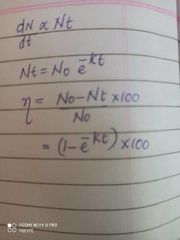
|
|
|
|
Orthotolidine test |
By comparing colour with a colour of known concentration Free and combines chlorine is found out separately Presence of Fe, Mn, nitrite give a false yellow colour. For such water, orthotolidine arsenate test is performed. Ordinary O-tolidine test done in 5 min When chloramine as a disinfectant, O-tolidine test done in 15 min. |
|
|
|
DPD test, chlorotex test, starch iodine test |
DPD test produce a red/pink colour solution Colour matching test Chlorotex test Determination of free chlorine from 0.1 to 1 ppm. Used in industries and research Starch iodine test Used when residual chlorine is greater than 1 ppm and also higher amount of iron & manganese if present in qater |
|
|
|
Aeration |
During aeration 1. Desorption of CO2 and H2S 2. Absorption of O2
Also remove Fe & Mn Method of aeration: 1. Spray Nozzle method - most efficient method - pressurises water is used to increases surface area of water - removes 90% CO2 & 99% H2S. 2. Cascade aerator Efficiency is 40% CO2 removal 20-45% & H2S removal 35% 3. Spray tower method - best method to remove Fe, Mn, & CO2 4. Tray tower & trickling bed - most efficient method of removal of CO2 used for Fe& Mn removal 5.Diffused air aerator Water absorb O2 from compressed air and colour, odour, taste are removed. |
|
|
|
Lime soda process |
Lime + sodium carbonates Can removed hardness upto 50mg/L
Lime removes carbonates hardness of Ca,Mg and non carbonate hardness of Mg. Soda removes non-carbonates hardness of Ca. Suitable for turbid and acidic water. |
|
|
|
Zeolite process or cation exchange process |
Complex compound of aluminium, silica, soda Na2O Al2O3. x SiO3. y H2O (green sand) Regeration of Zeolite Ca/MgZ + Nacl ----> Na2Z + Ca/MgCl2 NaCl (5-10% brine solution) (5 kg Nacl+ 95kg water) |
|
|
|
Ion exchange process |
Zero hardness No sludge formed Not suitable for turbid water Costlier for water containing Fe& Mn |
|
|
|
Water softening - Demineralisation/Deionisation process |
Metalic ion are exchanged for hydrogen ion Ion exchanger is prepared with carbonaceous material or resion Effluent quality is same as distilled water |
|
|
|
Removal of colour, odour &taste |
Aeration Treatment by activated carbon Use of copper sulphate |
|
|
|
Removal of Fe & Mn |
Can be removed by aeration, followed by sedimentation, coagulation & filtration |
|
|
|
Flouridation & Deflouridation |
Flouridation Using sodium flouride Deflouridation Activated alumina Nalgonda technique |
|
|
|
Desalination |
Distillation Reverse osmosis Electro dialysis Freezing Demineraliszation Solar evaporation |
|
|
|
Pressure for various building |
Single storey -7m Double storey -12m Triple storey -17m |
|
|
|
Grid iron/reticulated/interlaced system |
Suitable for well planned city One main pipe runs through centre and braches and laterals runs in grid pattern which are interconnected No dead end |
|
|
|
Ring or circular |
-Suitable for well planned city with well planned road - Supply main laid all along the periphery of road System follows grid pattern & follow pattern similar to dead end system |
|
|
|
Radial or zonal system |
Center reservoir flow the water outer periphery Pressure is more Higher service head and efficient water distribution |
|
|
|
Metallic pipes in water conveyance |
1. Cast iron pipes - used as mains 2 steel pipes : used when inside pressure is high 3. Wrought iron or GI pipe Used as distribution inside a building |
|
|
|
RCC pipes in conveyance |
Life span -75 years Don't corrode from inside Can resist ext. Compression loads Can't withstand high pressure |
|
|
|
Cast iron pipe in conveyance |
Life span : 100 year Corrosion resistance Manufactured by Foundry method Horizontally casted pipe: Mc vane pipes Vertically casted pipe : pit cast pipes Cetrifugal process Known as Spun-iron |
|
|
|
Steel pipe |
Used as water main passing over bridge and culvert for longer span Can withstand high pressure Can't withstand ext. Pressure Life span : 40 years |
|
|
|
Asbestos pipe in conveyance |
Silica+ cement under pressure : asbestos Highly flexible and permit only 12 degree deflection |
|
|
|
Joints in pipe lines |
1 spigot joint/Bell & spigot joint _ used to connect steel pipes & cast iron pipes Pipe fitting inserted into another pipe fitting 2. collar joint Used for connecting RCC pipes & asbestos pipes 3. Expansion joint Provided in metal pipe to take into a/c the change in pipe length due to temp variation contraction joints are not provided for water supply lines Flanged joint For temporary work where pipe joints may dismantled after work or shifted - avoid to use where there is a chance of deflection/ vibration Used where settlement of pipe line may occurs. Threaded joint For connecting Gl pipes Simplex joint Used for joining asbestos cement pipe Consist of a pipe sleeve & 2 rubber gasket Mechanical or dresser joint Mainly used in gas connection |
|
|
|
Appurtances from main line to housing connection |
Ferrule --> Goose neck--->service pipe--->stop cock---> water meter Ferrule : right angled sleeve - non ferrous metal - dia :10-50mm Goose neck : made of lead to provide flexibility - length about 75cm Service pipe: GI pipe of dia less than 50mm Water meter 1. Inferential type meter/ velocity meter : used for large pipe 2. Displacement type meter : used for small pipe & domestic connection |
|
|
|
Valves |
Gate valves or sluice valve or shut off valve Used to regulate the flow Placed at summit points as pressure to resisted by these valve is minimum Goose neck valve Used in high pressure region Air valves/air relief valve Provided at summit to release pressure Provided at u/s & d/s side of pressure U/s air valve : reduce air pressure D/s air valve : help to entering of air to reduce -ve pressure Check valve/Reflux valve/Non returning valve Permit flow in one direction Drain valve/scouring valve/blow off valve To remove salt, silt, deposited Butterfly valve To regulate flow in large sized pipe. Ball valves/Ball Float valves: Used to maintain constant level in an elevated tank or reservoir Pressure relief valve/safety valve Glob valve Regulate flow in small dia pipes ( dia <100mm) Flow change direction through 90 degree twice, high head loss Needle & cone valve Used as water hammer release valve Pilot valve Control high pressure or high flow feed Bib cocks Small sized water taps in washbasin, bathroom Fire hydrant Post hydrant : projected above road level Flush hydrant : provide below road level |
|
|
|
Location of leaks |
Methods adopted - direct observations - Using sounding rods - plotting HGL - using waste Detecting meters ( Deacon's meter) |
|
|
|
Specific yield |
Specific yield - volume of water released under gravity / total volume of aquifer Specific yield + specific retension = porosity |
|
|
|
Activated Sludge process (ASP) |

- suspended growth - aerobic biological treatment - can remove 90% of organic matter Components of ASP 1.Aeration basin , biosorption & biooxidation occurs. - organic matter is transformed into floccs 2. Aeration & mixing Aeration supplies enough O2 for aerobic biooxidation of organic matter 3. 2° sedimentation tank - to seperate and thickens biological flocs from mixed liquor for recycling or wasting 4. Sludge recycling - Thickened sludge is recycled back to aeration tank to maintain desired concentration of biological solids 5. Activated sludge wasting Either mixed liquor or thickened sludge system Addition of alkalinity or nutrient if required. Conventional ASP - flow model is plug flow type - aeration about 4-8 hours Rate of aeration is constant throughout the length of tank - bioflocculation, biosorption & biooxidation occurs.- organic matter is transformed into floccs2. Aeration & mixingAeration supplies enough O2 for aerobic biooxidation of organic matter3. 2° sedimentation tank- to seperate and thickens biological flocs from mixed liquor for recycling or wasting4. Sludge recycling- Thickened sludge is recycled back to aeration tank to maintain desired concentration of biological solids5. Activated sludge wastingEither mixed liquor or thickened sludge6. Chemical feed systemAddition of alkalinity or nutrient if required. Conventional ASP - flow model is plug flow type- aeration about 4-8 hoursRate of aeration is constant throughout the length of tank- during aeration period, adsorption, flocculation & oxidation of organic matter takes place. Tapered ASP- efficiency of aeration unit is increased- overall economy increased- maximum air is applied at begining and then reduces Step aeration - Sewage is added at more than 1 point- reduce the load on return sludge - aeration is uniform throughout the tank. 4. Completely mixed type Waste water is distributed along with return sludge uniformly from one side of tank and effluent is collected at other end. Plug flow type F/M and O2 demand will be highest at inlet end and progressively decreasesCompletely mixed typeF/M & oxygen demand will be same throughout - during aeration period, adsorption, flocculation & oxidation of organic matter takes place. Tapered ASP - efficiency of aeration unit is increased - overall economy increased 6. Chemical feed systemAddition of alkalinity or nutrient if required. Conventional ASP - flow model is plug flow type- aeration about 4-8 hoursRate of aeration is constant throughout the length of tank- during aeration period, adsorption, flocculation & oxidation of organic matter takes place. Tapered ASP- efficiency of aeration unit is increased- overall economy increased- maximum air is applied at begining and then reduces Step aeration - Sewage is added at more than 1 point- reduce the load on return sludge - aeration is uniform throughout the tank. 4. Completely mixed type Waste water is distributed along with return sludge uniformly from one side of tank and effluent is collected at other end. Plug flow type systemAddition of alkalinity or nutrient if required. Conventional ASP - flow model is plug flow type- aeration about 4-8 hoursRate of aeration is constant throughout the length of tank- during aeration period, adsorption, flocculation & oxidation of organic matter takes place. Tapered ASP- efficiency of aeration unit is increased- overall economy increased- maximum air is applied at begining and then reduces Step aeration - Sewage is added at more than 1 point- reduce the load on return sludge - aeration is uniform throughout the tank. 4. Completely mixed type Waste water is distributed along with return sludge uniformly from one side of tank and effluent is collected at other end. Plug flow type - maximum air is applied at begining and then reduces Step aeration - Sewage is added at more than 1 point - reduce the load on return sludge - aeration is uniform throughout the tank. 4. Completely mixed type Waste water is distributed along with return sludge uniformly from one side of tank and effluent is collected at other end. Plug flow type decreases Completely mixed type progressively decreasesCompletely mixed typeF/M & oxygen demand will be same throughout F/M & oxygen demand will be same throughout |
|
|
|
Completely mixed reactor with sludge recycle |
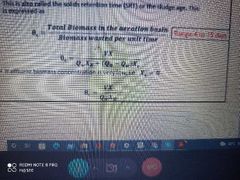
1. Hydraulic retention time Or detention time Or aeration period
T = V/Qo v: volume of aeration tank Qo= influent flow rate
HRT= 5-8 hours
Avg time at which the waste water flow will remains in aeration tank
______&&&_____
Mean cell residence time Or sludge age or solid retension time
- length of time the microorganisms stay in process
3. F/M ratio/ organic loading F/M= responsible for decomposition of organic matter - lower the F/M, higher the BOD removal -F/M increases, efficiency decreases - standard value of F/M = 0. 2 to 0.4 /day F/M = QoYi°/ VX X - mixed liquor suspended solids 4. Sludge recycling Qr/Q = X/(Xr-X) MLSS= both living and dead bacteria 5. BOD removal efficiency Efficiency = (Yi-Ye) *100/Yi Range = 85-95% 6.volumetric BOD loading/ volumetric organic loading = BOD load applied per unit volume of aeration tank U = QYi/V Range = 0.3-0.6 kg/day/m3 7.sludge volume index - it is volume of sludge in mL for one gram of dry weight of suspended solids measured after 30 min of settling Range: 50-150 mL/g Lower SVI, better settling of sludge SVI= settled sludge volume in mL/ suspended solid concentration (MLSS in gram) MLSS - mixed liquor suspended solids- both living & dead bacteria MLVSS - mixed liquor volatile suspended solids - only living bacteria - 80% of MLSS 8. Qty of return sludge MLSS = 1500-3000 mg/L for conventional ASP MLSS= 3000-6000 mg/L for completely mixed ASP Sludge return ratio= 20-50% F/M = 0.2-0.4 for convention ASP 0.2-0.6 for completely mixed ASP
|
|
|
|
ASP operational troubles |
1. Bulking of sewage 2. Rising of sludge Remedial measures 1. Elimination of industrial waste 2. Chlorination of sewage 3. Increased aeration 4. Raising the ph of sewage to 8 by adding lime |
|
|
|
In activated sludge process, the activated sludge is added to |
Effluent of 1° sedimentation tank |
|
|
|
% of activated sludge mixed with sewage in primary settling tanks |
20-40% |
|
|
|
Trickling Filter |
- Used to small & medium cities - attached growth system - filter bed depth -2 m & consist 50mm size angular stone Discharge head - 0.5-0.8m - attached biomass called biological film Or slime layer - facultative bacteria is predominant organism in TF - in std rate TF, screening & primary sedimentation is must before sewage applied through TF - Filter media - broken stone or slag (25-75mm) Schmutzdecke /slime layer/bio film/dirty skin = layer formed by microorganisms & organic matter around the Filter media Sludge from SST in TF : Humus Sloughing : dettachment of slime layer as an anaerobic condition develop below the slime layer due to excess thickness of slime layer |
|
|
|
Types of filters in TF |
1.Contact beds/contact filters Efficiency = 60-75% 2. Intermittent sand filter - require large area (1000-4000m2) - for treating sewage from tuberculosis hospitals Efficiency - 90-95% 3. Low rate trickling filter - conventional TF - depth of filter media = 2-3 m Size of filter media = 25-75mm Efficiency - 75-80% 4. High rate TF - recirculation is provided - less space & less filter media Efficiency - 80-95% Efficiency of TF= BOD removed/BOD applied Efficiency of TF= 100/(1+0.0044√u) U= organic loading in kg/ha.m/day |
|
|
|
Recirculation ratio in TF |
Recirculation ratio(R/I) = volume of sewage/ volume of raw sewage Filter loading 1. Hydraulic loading hL= amount of sewage flow that can be applied per unit surface area of filter per day 2.organic loading u= amount of BOD in kg applied on to the per unit volume of filter |
|
|
|
TF - operational troubles |
1. Ponding trouble 2. Fly nuisance - Psychoda fly/filter fly 3. Odour nuisance Adding chemical like chlorine, Copper sulphate help to resolve operational trouble |
|
|
|
2° sedimentation tank or secondary clarifier or secondary settling tank |
- type IV settling ( compression settling) - objective of SST Produce sufficiently clear effluent Minimise qty of sludge Designed on the basis of Solid loading rate & overflow rate In the upper portion of SST, type III settling & lower portion of SST, type IV settling SLUDGE THICKENER - to reduce the volume to be handled in sludge digester, sludge thickener is provided. Sludge thickening is done by Gravity, centrifugal, seeding SLUDGE BULKING - sludge with poor settling characteristic - poor effluent due to excess decomposed organic matter - occur due to $ inadequate air supply $ Low pH Reduced by $ Chlorination of returned activated sludge $ Addition of nutrient |
|
|
|
Sludge treatment |
In sludge, 88-99.5% moisture content In sewage, 99.9% moisture content Sludge treatment 1. Volume reduction 2. Strength reduction By 1. Sludge thickening : to reduce moisture content. Done by gravity thickening & air floatation 2. Sludge digestion : decompose organic matter in sludge by aerobic and anaerobic digestion 3. Sludge conditioning : to enable the drain ability of sludge. Removal of moisture with heat & chemical treatment 4. Sludge dewatering & drying : removal of remaining water content & also reduce volume of sludge 5. Incineration : 650-750°c |
|
|
|
Moisture content of digested sludge / volume reduction |
For raw sludge - 95 % moisture Sludge from TF - 96-98% moisture Sludge from ASP - 98-99% 90% mc sludge = 10 litre solid matter in 100 litre sludge V1(100-P1) = V2 (100-P2) |
|
|
|
Sludge digestion |
1° settling tank - organic content more - Sludge is called 1st degree sludge - anaerobic digestion 2° settling tank - designed based sludge flux rate - 2nd degree sludge - Aerobic digestion Sludge digestion - done in sludge digestion tank (abt 29°C) - anaerobic process ( also facultative) - volume reduced to = 1/3 of undigested sludge Aerobic digestion - for sludge from 2° sedimentation tank only - require external energy - more operational cost & lesser capital cost Anaerobic digestion - for primary sludge only - convert as much as sludge as possible to liquid & gas -2 stages of decomposition : acid formation & methane formation |
|
|
|
Stages in anaerobic digestion |
1. Hydrolysis 2. Acid Fermentation ( Acidogenesis) 3. Methane formation ( Methanogenesis) Or 1. Acid fermentation 2. Acid regression 3. Alkaline fermentation 4. Methane formation |
|
|
|
Sludge digestion - stages of decomposition |
1. Acid fermentation stage or acid production stage (15 days) - fresh sewage is acted up by anaerobic & facultative bacteria called acid formers - solubilize organic solid through hydrolysis - converted to volatile acid like propionic acid, acetic acid - gases are evolved BOD of sludge increases to some extent 2. Acid regression stage ( 3 months) Volatile organic acid ----> acid carbonates& ammonia compound - ph increses - BOD remains high 3. Alkali fermentation (1month) - methane formers - liquid, digested sludge & gases separated - BOD of sludge decreases rapidly - digested sludge collected at the bottom of digestion tank - Ripened sludge Sludge get broken down into 3 forms in anaerobic digestion 1. Digested sludge - stable humus like solid mass, tary black colour, free from pathogens, may contain bacterial cysts, eggs Volume reduced to = 1/3 of undigested sludge - dried up and used as fertilizer 2. Supernatant liquor BOD = 3000 ppm Handling is difficult Finely divided solid matter & liquid Retreated in treatment along with raw sewage 3. Gases of decomposition Methane - 65-70% CO2 - 30% Remaining - nitrogen, hydrogen sulphide |
|
|
|
Factors affecting sludge digestion |
1.Temp - opt temp -29°C (mesophilic digestion) - opt period -30 days 2. Ph - alkaline condition ( ph 6.5-7.5) - adding lime 3.Seeding with digested sludge 4.Mixing & steering of raw sludge with digested sludge 5. Nuisance organism |
|
|
|
Capacity of sludge digestor |
{( Vf+ Vd) /2}*t t= digestion period M= mass of raw sludge Vf = volume of fresh sludge =( 100*M) /((100-P1) *ef) Vd= volume of digested sludge = (100*M) /((100-P2) * ed) |
|
|
|
Disposal of sewage effluents |
1. Dilution(disposal in water) - common method 2. Effluent irrigation or broad irrigation or sewage framing (disposal on land) |
|
|
|
Dilution ( disposal on water) |
Dilution factor : ratio of quantity of the diluting water to that of the sewage. DF>500 - no treatment required DF= 300-500, sedimentation, suspended solids <150ppm DF = 150-300, sedimentation+ chemical precipitation, suspended solids < 60ppm DF < 150, complete treatment required, suspended solid < 30 ppm , BOD<20ppm |
|
|
|
Tolerance limits for sewage effluent discharged into surface water source as per IS 4764-1973 |
BOD5 - 20mg/L TSS - 3 mg/L |
|
|
|
Disposal on land |
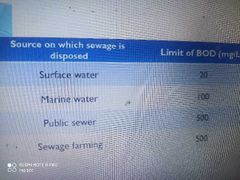
Effluent irrigation/ sewage farming / Broad irrigation - increase crop yield - pblm is sewage sickness |
|
|
|
Self purification of rivers |
Dilution, sedimentation, oxidation, reduction, sunlight
1. Physical forces: a). Dilution & dispersion : Concentration of resulting mixture = (CsQs+ CrQr) /(Qs+Qr)
b). Sedimentation c). sunlight: has bleaching & stabilising effect of bacteria
2. Chemical forces aided by biological forces a). Oxidation - most important action in self purification
b) reduction
|
|
|
|
Effect of temperature, sunlight on self purification of rivers |
1.Sunlight: accelerate self purification 2. Temp: At high temp, self purification takes lesser time, qty of DO will be less DO is inversely proportional to temp 3. Sedimentation : If dilution factor is sufficient, no anaerobic condition will occur. 4. Oxidation : 5. Reduction: anaerobic bacteria - reduction assist self purification DO is directly proportional to self purification. Algae absorb CO2 and gives O2, helpful in self purification. |
|
|
|
Deoxygenation, deoxygenation and oxygen sag curve |
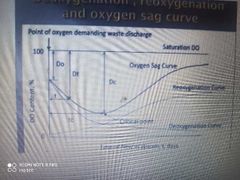
|
|
|
|
Zones of pollution in river |
1. Zone of degradation - water becomes dark & turbid - DO reduced to 40% of saturation value - fish present - aquatic life such algae absent 2. Zone of active decomposition - marked by heavy pollution - greyish & darker water. - fish will be absent - DO falls to almost zero 3. Zone of recovery - BOD falls & DO increases - DO content rises above 40% - Fishes reappear 4. Zone of cleaner water/ saturation -DO rises to saturation value - aquatic life reappear |
|
|
|
Streeter- Phelps eqn |
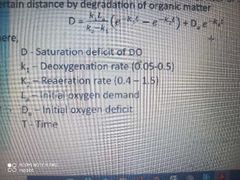
- to study water pollution as water quality modeling tool - model describe how DO decreases in water of river along a distance by degration |
|
|
|
Deoxygenation, reoxygenetion |
Deooxygenetion curve indicates DO content remaining in the stream afer satisfying BOD. Reoxygenetin curve indicates oxygen absorbed by stream Oxygen sag curve : DO deficit at different time |
|
|
|
Comparison of aerobic & anaerobic process |
Anaerobic digestion recovers the energy in the form of methane only. -in anaerobic, pathogens completely died out - anaerobic has lower operational cost - demerit of anaerobic : require closed process control to prevent aerobic condition - |
|
|
|
Oxidation pond/water stabilization pond |
Long DT Symbiotic relation - end pdcts are CO2 & water Top layer: aerobic, middle facultative, bottom anaerobic Combined action of aerobic bacteria + algae - effluent of oxidation pond used for land irrigation -90% BOD removal - sodium nitrate is added to enhance algae growth |
|
|
|
Design parameters of oxidation pond |
Depth = 1-1.5m DT= 15-30 days BOD removal = 80-90% Sludge accumulation = 2-5cm per year Minimum depth of water to be kept in pond = 0.3m L/B ratio = 2.5-3, L <750m Organic loading = 150-325 kg BOD5/ha/day Effluent of OP is not discharged into river, becoz it contaion algae |
|
|
|
Design criteria for oxidation pond |
Organic loading For hot countries = 150-300 kg/ha/day For cold countries = 60-90 kg/ha/day Area = 0.5-1 ha Depth = 1-1.5m DT = 2-6 weeks (20-30 days) Cleaning of settled sludge = once on 6 years |
|
|
|
Rotating biological contactor RBC |
- Aerobic attached growth system - 3-6rpm - 40% dia of disc immersed - sludge accumulation possible |
|
|
|
Mechanically aerated lagoons |
Deeper oxidation pond with artificial aeration which has less DT & less area Depth = 2.4-3.6m DT= 4-10 hrs Area reqd : 5-10% of an equivalent oxidation pond Efficiency = 65-90% |
|
|
|
Oxidation ditch(Pasveer type) / extended aerated lagoon |
Long continues channel oval in shape Modified form of extended aeration of ASPLong continues channel oval in shapeModified ASP to eliminate primary sedimentationLonger DT depth of tank = 1-1.5mDT= 12-15 hrsCan removed 98% BOD Modified ASP to eliminate primary sedimentation Longer DT depth of tank = 1-1.5m DT= 12-15 hrs Can removed 98% BOD |
|
|
|
Anaerobic treatment |
1. Septic tank - sedimentation tank with longer DT - sedimentation & decomposition in same tank - effluent disposed off by sub- surface irrigation or soak pit or drain field or treated in TF - dia of connecting pipe to septic tank = 50mm |
|
|
|
Design criteria for septic tank |
DT = 12-36 hrs (generally 24hours) Frequency of cleaning - 0.5-3 yrs (generally 1 yr) Length to width ratio = 1:2 or 1:3 Minimum width = 75cm Sludge =30 L/capita/year Depth = 1.2-1.8m Fee board = 0.3!m BOD of effluent = 200 mg/L |
|
|
|
Anaerobic treatment - imhoff tank |
- consists of two chamber vertically Upper sedimentation chamber & lower digestion chamber More depth & costlier Rarely used |
|
|
|
Anaerobic treatment - Upflow anaerobic sludge blanket reactor (UASB) |
- operates by principle of suspended growth system - can be used for large scale water treatment DT = 6-8 hrs Advantages: 1. Higher reduction in BOD 2. Can withstand high organic & hydraulic loading rate 3. Low sludge production 4. Biogas used for energy Disadvantage 1. Unstable for variable hydraulic & organic loads 2. Require skilled labour 3. Long start up to work at full capacity 5. Require expert design & construction 5. Can't remove toxic pollutant like heavy metal |
|
|
|
Disposal of waste water in lakes |
Study of lakes : limnology Aerobic depth of water in lake = Epilimnion Lower depth of lakes : Hypolimnion (anaerobic, cooler, poorly mixed) Middle depth of lake : thermocline/Metalimnion In winter, entire depth of lake is aerobic entire depth of lake is aerobic |
|
|
|
Productivity of lakes |
- Productivity : ability to support food chain - measure of algal growth - higher algal growth, decreased water quality - based on increasing level of productivity 1. Oligotrophic lake - hypolimnion very small 2. Mesotrophic lake - 3. Eutrophic lake 4. Senescent lake - very old lake almost marshy |
|
|
|
Eutrophication of lakes |
Nutrients responsible are carbon, nitrogen, phosphate Increase phosphate in lake water accentuate eutrophication Remedial : add lime and dredge out sediment at the bottom To avoid eutrophication, no disposal of raw sewage or treated sewage into water |
|
|
|
Disposal on land |
BOD = 500 mg/L Effluent irrigation or broad irrigation : chief consideration is succesful disposal of sewage Sewage farming : successful growing of crops |
|
|
|
Common effluent treatment plants (CETPS) |
- reduce effluent treatment cost - better collective treatment - reduced land cost for small scale industrial facilities |
|
|
|
Treatment to industrial waste water |
1. Equalization - equalisation of contaminants & equalisation of flow - discontinuous flow - used to reduce amount of chemicals utilized 2. Neutralization - neutralize excess alkali or excess acid - done in equaliser tank or separate tank 3. Physical treatment a. Screening b. Sedimentation c. Floatation d. Filtration 4. Chemical treatment - essential treatment in the treatment of industrial wastewater - coagulation, chemical precipitation, RO, chemical oxides, adsorption, ion exchange, air stripping, electrodialysis 5. Biological treatment BOD/COD>0.6 = biologically treatable 0.3<BOD/COD<0.6 = Acclimatization is necessary BOD/COD<0.3, no need of biological treatment |
|
|
|
The method in which different type of refuses are disposed off separately |
Dry method & conservancy method |
|
|
|
For house drainage & lateral connection, type of sewer used |
Stone ware sewer |
|
|
|
For sewers of dia less than 600mm, the type of joint preferred |
Collar joint |
|
|
|
Lower portion of manhole |
Working chamber Min dia of manhole cover = 50cm |
|
|
|
Drop manhole is provided if |
Branch sewer discharge into main sewer at a higher lever |
|
|
|
A good trap should |
Provide an adequate water seal at all times |
|
|
|
Building sanitary drainage systems |
1. Two pipe system - Independent stacks for soil & waste water with anti siphonage pipe - both pipes ventilated separately - Best system for efficient conveyance of house wastes.
2. One pipe system - Combined stack for soil & waste water with anti siphonage pipe. - Pipe is directly connected to the drainage system
3. Single stack system - Combined stack for soil & waste water without anti siphonage system or vent pipe - extended upto 2m to 3m higher than roof level and provided with cowl for foul gases. |
|
|
|
Most suitable excreta disposal unit for human excreta |
Privy pit (pit - toilet) : self - contained waterless toilet used for disposal of non water carried human waste Privy pit should be located at least 3m from the well or other ground water supply |
|
|
|
Cess pool |
Underground structure in the form of circular or rectangular tank for the purpose of admitting sewage into it from the intercepting chamber |
|
|
|
Equipment used for removing paper and rags from sewers |
Claw Eqmnt used for cleaning sewers easily - scraper |
|
|
|
Land disposal of sewage is flavourable where |
The rivers run dry or or small flow during summer |
|
|
|
ASP |
Require small area for construction Require smaller water head for operation than TF High efficiency |
|
|
|
Grit chamber of a sewage plant are usually changed after |
2 weeks |
|
|
|
Dose of lime in excess lime treatment |
10-20 ppm |
|
|
|
Chlorination of water does not affect |
DO content |
|
|
|
COD test |
Oxidant : potassium dichromate Acidic medium : Conc. H2SO4 Titrant : Ferrous ammonium indicator Indicator : Ferroin COD>BOD |
|
|
|
Most effective type of storm releif work |
Syphon spillway Discharge more water in lesser time - automatic operation - less maintenance |
|
|
|
Most effective type of storm releif work |
Syphon spillway Discharge more water in lesser time - automatic operation - less maintenance |
|
|
|
Sludge bank |
Sewage solids reacts with dissolved solid in sea water giving milky appearance. - Produce H2S |
|
|
|
Equipment used for checking sewer invert level |
Boning rod or traveller ( T shaped rod of adjustable length) |
|
|
|
Terms in waste water |
Refuse: general term to indicate waste Garbage: dry refuse Rubbish : sundry solid waste from residence, offices. And combustible Sewage : 99.9% water Sanitary sewage : sewage from residential blgs & industrial effluent Storm water : surface runoff Sullage: discharge from kitchen, bathroom, wash basin. Dry weather flow (DWF) : domestic sewage + industrial sewage Wet weather flow : sanitary sewage + storm water |
|
|
|
Sewerage system |
Seperate sewerage system - adopted where high rainfall intensity or where rainfall is unevenly distribute - where deep excavation cannot be easily done Combined sewerage system - adopted for less rainfall intensity - where rainfall is evenly distributed - in plane areas where excavation are easy & less costly Partially seperate sewerage system - designed to carry sewage & a portion of storm water from bldgs, roof truss |
|
|
|
Types of sewer |
House sewer : - start point of sewerage system - collects waste water from individuals house Lateral /branch sewer : It receives discharge from no. of independent house sewer Sub mains : Receives discharge from two or more barch sewer Trunk / Main sewer : Outfall sewer: |
|
|
|
Types of sewer - based on shape |
Circular sewer : - used in seperate system - utilizes min. qty of materials, economic al Egg shaped sewer : - used in combined system - chaance of particle settling inside sewer is less - can maintain higher velocities ( 2 to 15% more than circular) - smaller circular section effective during DWF & larger circular section is effective during max rainfall. Horse show shaped sewer: - used in trunk& outfall sewer Parabolic sewer: Used for carrying small qty of sewer Rectangular sewer : Used for carrying storm water
|
|
|
|
Sewer appurtances |
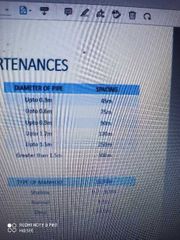
1. Manhole Helps in inspection, cleaning & maintenance of sewer. - spacing of manhole : IS 1742 -1960 - minimum dia of opening of manhole : 50cm - LD -25 : grade of manhole cover for residential areas
Difference in level b/w invert level of branch sewer and water line in main sewer is greater than 0.6m 2. Drop manhole Difference in level b/w invert level of branch sewer and water line in main sewer is greater than 0.6m_ dia of drop pipe - at least equal to incoming pipe
_ dia of drop pipe - at least equal to incoming pipe
3. Lamp hole - Constructed where construction of manhole is difficult. - also used for flushing the sewer Fresh air inlet : top layer perforated in lamp hole and help in ventilating the sewer 4. Clean out provided at the upper end of lateral sewer During blockage of pipe, cover is taken out, water is forced to clean out pipe. 5.stormwater inlets - provided to admit the surface runoff to the sewer - Curb inlet, gutter inlet and combined inlet - connecting pipe from street inlet to sewer - min 200m Max spacing b/w inlet - 30m 5. Catch basin Provided to stop entry of heavy debris present in storm water into sewer. 6. Inverted siphon or depressed sewer - sewer that run full under gravity flow at a pressure above atm - Used to pass under obstacles as subway, buried pipe 7. Regulators - used for preventing overloading of sewers, pumbing station by diverting excess flow to relief sewer Eg : leaping weir : a part of excess sewage leap across the opening & diverted from intercepting sewer Intercepting sewer at right angle to combined aewer |
|
|
|
Ventilation of sewers |
1. Ventilating column - placed at an interval of 150-300m 2. Ventilating manhole - perforation in manhole cover 3. Forced draught - air removal by mechanical means 4. Vent pipes - provided in house |
|
|
|
Cleaning of sewer |
Small sewer - by flexible hose called flushing Medium sewer - using scrapping instrument called cane rodding Large sewer - by manual labour |
|
|
|
Precaustions while entering a sewer |
1. Insert lead acetate paper - black colour indicates presence of H2S 2. Insert Minor safety lamp in the upper layer of sewer and remove immediately - spark indicate presence of CH4 3. Insert minor safety lamp into lower layer of sewer - Flame extinguish indicated the presence of CO2 4. Insert a lighted lantern - bright burning indicates presence of sufficient O2 |
|
|
|
Types of pipes |
Waste pipe : carry only liquid waste from kitchen, wash basin. Also carry human excreta Min dia - Horizontal : 30-50mm & vertical : 75mm Vent pipe : for ventilation purpose Min dia: 50mm Soil pipe : carries human excreta from water closet to septic tank Min dia = 100mm Rain water pipe Min dia : 75mm Antisiphonage pipe: Pipe installed in house drainage to preserve water seal in traps. -prevent entry of foul gases - it is connected to top of P trap Min dia: 50mm |
|
|
|
Traps |
Prevents passage of foul gases Depth of water or trap seal varies - 25-75mm (generally 50mm) P trap Trap used in water closet. Legs are right angle to each other. - used in indian WC Q trap or half S trap Two legs meet at an angle other than right angle S trap /sink trap Both legs are parallel to each other Floor trap /Nahni trap - collect waste water from floors of kitchen, bathrooms - have a small water seal - min 50mm Gully trap - provided at junction of a room Or roof drain and other drain coming from bathroom, kitchen - Foul sullage will enter though side inlet (back inlet) -water seal : 50-75mm Intercepting traps - provided at the junction of house sewer & municipal sewer - prevent entry of foul gases from muncipal sewer Min depth of water seal - 100mm Grease trap - Used in large restaurants, hotels (food processing units) - prevents the entry of large quantity of oily waste Silty trap - prevent entry of silts into drain * Rcc slab in toilet portion should be sunk by 50cm below general floor level for indian type WC * height of sink if wash basin is above floor level = 75cm * Capacity of flushing system = 14 litres |
|
|
|
Design of sewers |

Assumptions: 1. Flow of waste water in sewer is steady & uniform 2. Design of sewer is based on peak flow discharge 1. Hazen william's formula V = o. 85 C R ^(0.63) S^ (0.54) 2. Manning formula V= (1/n) R ^(2/3) S ^(1/2) R= wetter area /wetter perimeter 3. Darcy weisbach formula hL = (fLV^2) /(2gd) Sewer are designed as open channel flow Sanitary sewer are designed to run partially full condition |
|
|
|
Minimum velocity in the design of sewer |
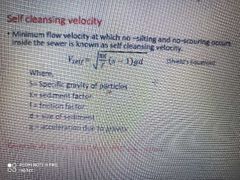
For impurities like sand upto 1mm dia with G= 2.65 & organic particle upto 5mm dia with G=1.2, minimum velocity = 0.45m/sec Avg velocity in sewer = 0.9m/s Minimum velocity generated at minimum discharge (I.e, abt 1/3 of avg discharge) Self cleansing velocity = 0.75m/s (0.6 - 0.9 m/s) PSC key - < 1 m/s Non- scouring velocity Max flow velocity at which no scouring - limiting or non- scouring velocity depends on material of sewer |
|
|
|
Non- scouring velocity |
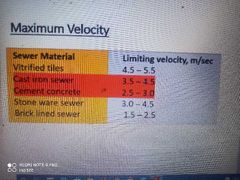
|
|
|
|
Design sewer |
Sewer are designed for max hourly discharge & checked at min hourly discharge Max hourly discharge = 3* avg daily discharge Max daily discharge = 2 * avg daily discharge |
|
|
|
Estimation of DWF |
Qty of waste water generated= 75-80 % of total water supplied Qdwf = per capita demand * population * (0.75 to 0.8) Sewerage system is designed on the basis of Max flow & min flow |
|
|
|
Peak sewage flow |

|
|
|
|
Partial flow characteristics of circular sewer |
For Max velocity d/D = 0.81 For Max discharge d/D = 0.95 d= depth of flow D = dia of sewer |
|
|
|
Testing of sewer pipe |
Test for leakage - air test, water test, smoke test Test for obstruction - ball test Test for Straightness - mirror taste |
|
|
|
Avg temp of sewage in india |
20°C |
|
|
|
Decomposition |
Decomposition = Oxidation + Reduction Oxidation : aerobic process - end pdct:CO2, nitrates, sulphates Reduction: anaerobic process - end pdct - CH4, CO2, NH2, H2S |
|
|
|
Physical examination of sewage |
Ph |
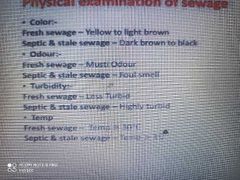
|
|
|
Chemical characteristics of sewage |
1. pH Fresh sewage - alkaline Septic sewage - acidic 2. Solids Suspended, dissolved, colloidal, settleable Suspended or filterable: >100nm Dissolved : < 1 nm Colloidal : 1-100nm Settleable: Undisturbed for 2 hours Settleable solids : Imhoff cone Chemical examination of sewage Conducted to Inorganic content of sewage Organic content of sewage Dissolved gas in sewage 1. Organic content No straight forward test to find organic content in waste water. Oxygen demand is proportional to organic matter present. Therefore oxygen demand test are conducted Dissolved oxygen - to know extend of pollution of sewage -Saturation DO content at 20°C = 9.2ppm - if the temp of sewage is more, DO content is less |
|
|
|
Organic content determination - indirect method |
1. BOD 2. COD 3. TOD 4. ThOD BOD Conducted at 20°C for 5 days DOmix = DO initial DO mix = {volume of sample* DO of sample + volume of distilled water * DO of distilled water}\total volume |
|
|
|
BOD |
Dilution factor = 100/% of dilution = final volume/initial volume= volume of distilled sample/ volume of undiluted sample DF = no of times sewage is diluted with distilled water BOD5 at 20°C = 67% of ultimate BOD Permissible value of BOD in water = O |
|
|
|
Analytical method to estimate BOD |
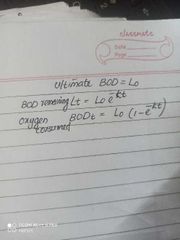
|
|
|
|
Analytical method to estimate BOD |
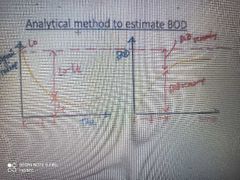
Lt = BOD remaining Lo - Lt = BODt = BOD removed |
|
|
|
Population equivalent |
- strength of industrial waste water for estimating the treatment reqd at the municipal treatment plant - avg BOD of domestic sewage = 80 g/capita/day Population equivalent = ( total BOD5 of the industry in kg/day) / 0.08kg/day |
|
|
|
Relative stability |
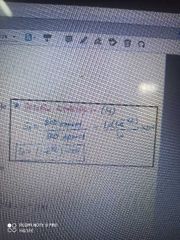
Ratio of available oxygen to the required oxygen satisfying the first stage BOD. Available oxygen = DO+ oxygen present as nitrate Or nitrite Expressed as % of total oxygen required At 20°C, Sr = (1- 0.794t) *100 t= time |
|
|
|
Relative stability |
BOD removed/BOD applied |
|
|
|
Ultimate BOD |
Amount of biodegradable organic matter present in the sewage. |
|
|
|
Aerobic & anaerobic reaction |
Aerobic reaction: produce stable inorganic end products with relatively low energy content Anaerobic reaction : slow, do not remove organic content completely |
|
|
|
Classification of micro organism |
Autotrops : derive both energy and material from inorganic substances eg : algae Heterotrops : derive both energy & material from organic substance. Eg : bacteria Phototrops : utilize sunlight as energy source & inorganic substance as material source Facultative Hetrotrop : Aerobic hetrotrops: Anaerobic hetrotrops: Saprophytic bacteria : comes under hetrotrops. Mostly used in secondary treatment |
|
|
|
Bacteria based on temperature |
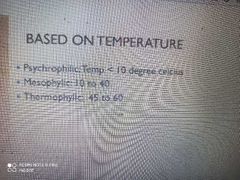
|
|
|
|
COD |
Amount of oxygen reqd to oxidise organic matter Done by using a strong chemical oxidant such as potassium dichromate COD is greater than Or equal to BOD |
|
|
|
COD determination using reflux method/ apparatus by COD digestor |
Oxidant : potassium dichromate Catalyst : silver sulphate Acidic medium : conc. H2SO4 Inhibitors : mercuric sulphate Titrant : Ferrous ammonium sulphate Indicator: ferroin ( blue green to reddish brown) |
|
|
|
BOD /COD ratio |
BOD/COD >= 0.6 (0.63-0.68) --- biodegradable organic matter is more BOD/COD <0.6 ---- non biodegradable organic matter is more BOD =0 , COD not equal to zero --- toxic water BOD= COD= 0, synthetic waste, waste water is free from organic matter |
|
|
|
Total oxygen demand TOD |
Amont of oxygen required to oxidise bio degradable & non- biodegradable organic matter along with few inorganic substances which are Oxidisable |
|
|
|
ThOD |
Oxygen demand calculated by plotting graph b/w organic matter present & oxygen present |
|
|
|
Treatment of sewage |
1. Preliminary treatment : removing objectionable matter which interface with BOD removal. 2. Primary treatment : removal of settleable organic matter 3. Secondary treatment : biological conversion of dissolved & colloidal organic into biomass, and removed by sedimentation 4. Tertiary treatment : for reuse & recycling of treated waste water |
|
|
|
Treatment of sewage |
Preliminary treatment: screening, grit chamber, Detritus tank, skimming tank 1° treatment : sedimentation 2° treatment : aerobic & aerobic treatment 3° treatment : disinfection |
|
|
|
Screening |
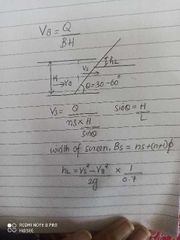
First unit operation in waste water treatment - remove large floating objects - screens are placed at 30-60° with hori. Velocity of approach = 0.6-1.2 m/a Flow velocity through screen = 0.8-1m/s Coarse screen : spacing of bars > 50mm Medium screen : spacing of bars 20-40mm (6-40mm) Fine screen : spacing of bars 1.5-3mm (3-5mm) |
|
|
|
Grit chamber |
- To remove grit from waste water - Grit is not removed, increase wear & tear and abrasion on mech. Eqmnt - Grit composed of 1.inorganic matter (size >o.2mm & G >2.65) 2. Non biodegradable organic matter (size >2mm & G= 1.05-1.1) Velocity control devices 1.proportional flow weir 2.sutro weir 3.parabolic grit chamber 4. Parshall flume - used to remove particle of size o. 2mm Or more - velocity of flow through grit chamber: 0.2-0.4 m/s (generally 0.3m/s) - detention time - 1 min (40-60sec) Depth :1-1.5m Free board = 0.3m Stoke law cannot be applied SOR = 2160 m3/m2/day Length of channel is increased by 20% for inlet & outlet turbulence |
|
|
|
Detritus tank |
- Grit chamber with longer detention time and smaller flow velocity -used to settle finer particle DT = 3-4 min (3-5min) Flow velocity = 0.09m/s |
|
|
|
Skimming tank |
- used to remove oil - if not removed, inhibits biological growth on trickling filter and interfere with activated sludge process |
|
|
|
Plain sedimentation in sewage treatment |
- removes all settleable organic matter 70% of biodegradable settleable solids 30% of BOD removal Type III settling - hindered or zone settling SLR or SOR = 30-50m3/m2/day DT = 1.5-2.5 hours 60-65% total solid removed |
|
|
|
Secondary treatment |
- remove soluble BOD which is present in colloidal & dissolved form BOD/COD < 0.6 , physio- chemical treatment eg: chemical coagulation, chemical absorption, micro screening, filtration BOD/COD>0.6, Biological treatment , complete process by micro organism, adopted for our waste water treatment |
|
|
|
Sewage treatment |
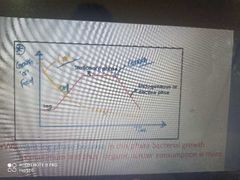
Aerobic treatment Complex matter+ bacteria + O2 ----> Co2 + NH3 + energy Very fast, large amount of sludge produced, further treatment of sludge is reqd Aerobic treatment Complex organic matter + bacteria ----> CO2+CH4+ energy Slow process, useful byproduct like CH4, sludge is less |
|
|
|
ASP, TF |
Waste water is first treated by aerobic biological treatment method The byproduct obtained in aerobic treatment are treated again Anaerobically Attached growth process eg: trickling fliter, bio tower, rotating biological contactor Suspended growth process Eg: ASP, Oxidation ditch |
|
|
|
2° treatment - aerobic & anaerobic methods |
Aerobic method ASP, Trickling filter, oxidation ponds, rotating biological contactors, mechanically aerated lagoons, oxidation ditch Anaerobic methods UASB reactor ( up flow anaerobic sludge blanket) Septic tank Imhoff tank |
|
|
|
Good rich formula |
to find peak demand/average demand
P= 180 t^(-0.1) t in days
Max daily demand/avg daily demand =180%
Max weekly demand/avg weekly demand=148%
Max monthly demand/avg monthly demand = 128% |
|
|
|
Population & peak factor |
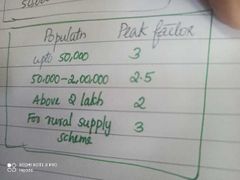
|
|
|
|
Population & demand in lpcd |

|
|
|
|
Fire demand |
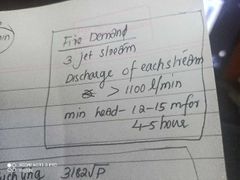
|
|
|
|
Design period for various units |
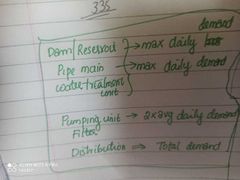
|
|
|
|
1 mL of 0.02N H2SO4 will neutralize 1 mg as CaCO3 alkalinity |
So 30 mL 0.02N H2SO4 will neutralise 30 mg as CaCO3 in 200mL (volume given) So =30mg/200mL alkalinity = 150mg/L alkalinity as CaCO3 |
|
|
|
Carbonate hardness (temperory hardness) |
Non-carbonate hardness ( permanent hardness) 1mole of lime required for removal of MgCO3 & 2 mole of lime required for removal of Mg(HCO3)2 |
|
|
|
Effective in chlorination |
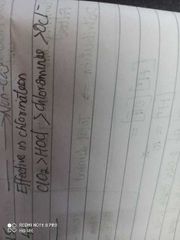
|
|
|
|
Quiescent tank |
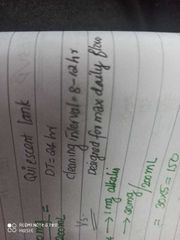
|
|
|
|
Chloride content of waste water of domestic nature |
120 mg/L |
|
|
|
COD test is also called |
Dichromate test |
|
|
|
Dilution factor |
DF = volume of diluted sample / volume of undiluted sample taken |
|
|
|
Vanthoff's aeheniers eqn |
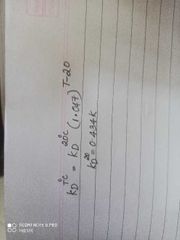
|
|
|
|
Population equivalent |
= total BOD5 of the industry in kg/day / 0.08 kg/day |
|
|
|
Peak sewage flow |
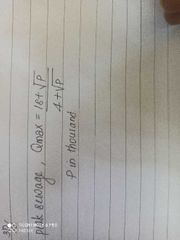
|
|
|
|
Diameter of pipe & spacing of manhole |

|
|
|
|
Manhole classification |
0.7-0.9m : shallow 0.9-1.5m : moderate >1.5m : deep |
|
|
|
Inorganic soils are removed by grit chamber |
Organic soil are removed by sedimentation tank |
|
|
|
Screening |
Coarse screen : clear spacing >50mm Medium screen : 20-50mm Fine screen :>20 mm |
|
|
|
Grit chamber removed particle whose G =2.6 Removes particle whose size is greater than Or equal to 0.2mm Stoke's law is not valid |
1° sedimentation tank removed particle whose G =1.2 |
|
|
|
UASB reactor |
Upflow anaerobic sludge blanket |
|
|
|
Trickling filter |
For small & medium works in temperature climate 2m deep circular bed of 50mm size stone Attached biomass called slime layer or biological film Std rate TF - facultative bacteria is predominant - screening & primary sedimentation is must before sewage passing to TF High rate TF - recirculation is done - recirculation permit high organic loading - high hydraulic loading reduces filter clogging |
|
|
|
Volumetric loading rate |
Volumetric loading rate = kg of BOD applied per unit volume of Reactor per day Organic loading rate = kg of BOD applied per unit mass of microorganism present in aeration tank |
|
|
|
Sludge volume index |
Volume of sludge in mL for 1 gram of dry weight of suspended solid measured after 30 min of settling SVI = 50-150 mL/g |
|
|
|
F/M ratio |
F/M = (So*Qo) /(V*X) =(BoD of waste water*influent flow rate) /(reactor volume* reactor biomass) Extended aeration : 0.05<F/M<0.15 Convention ASP : 0.2<F/M<0.4 Completely mixed : 0.2<F/M<0.6 High rate : 0.4<F/M< 1.5 |
|
|
|
Sludge recycling |
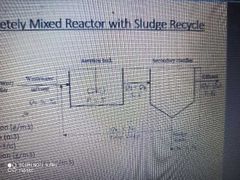
Recirculation ratio = QR/Q = X/(XR-X) |
|
|
|
In SST, hindered or zone settling in the upper portion of SST |
ln the lower portion of SST, compression settling |
|
|
|
Productivity of lake |
Oligotrophic lake : low productivity, no algal growth, hypolimnion is small Mesotropic lake : medium productivity, hypolimnion same as oligotropic Ectopic lake : high productivity & algal growth Senescent lake : very old lake almost become marshy |
|
|
|
BOD5 of waste water effluent to be discharged on land for irrigation |
500 mg/L |
|
|
|
Composting |
C/N ratio = 30-50 |
|
|
|
Pulverisation |
Pulverisation : to reduce the volume Incineration : exothermic, presence of oxygen Pyrolysis or destructive distillation : endothermic, in the absence of oxygen |
|
|
|
Photochemical smog |
HC + NOx sunlight---> PAN + ozone |
|
|
|
Traffic smog or modern smog |
Vehicular emission from internal combustion engine + sunlight ----> 2° pollutants |
|
|
|
Effects of various pollutants |
1. SO2 : brochial spasms, affects mucus membrane 2.CO : central nervous systems 3. Oxides of Nitrogen : eye & nasal discomfort & pulmonary irritation 4. H2S : contact period is small => fatigue of sense of smell Contact period is large ==> death 5. Ozone : respiratory system 6. Lead : automobile & batteries - liver & kidney dange, lesser mental growth in children 7. Insecticides : harmful to human |
|
|
|
Acid rain |
pH <5.6 ==> acid rain pH = 5.6 ==> clean rain Remedy : to neutralize acidity in soil, treat with lime |
|
|
|
Control of air pollution |
1. Gravity settling chambers : employed for large sized particles only - simple to design & maintain 2. Centrifugal gas collector : employes centrifugal force. Two types : cyclonic collectors & dynamic precipitator 3. Wet precipitator : remove particulate from gaseous flow |
|
|
|
Negative lapse rate or inverted lapse rate |
Temp of environment increases with altitude |
|
|
|
Stack |
Source of origin of plume is called stack Plume : path taken by continuous discharge of effluent emitted from stack or chimney |
|
|
|
Plumes |
1. Looping plume - occurs in super adiabatic condition - SALR is highly unstable & rapid mixing - rapid dispersion & high concentration tough the ground - higher stack required 2. Neutral plume : - ELR= ALR - vertical upward rise of plume from stack - upward flume continue till air density is that of plume 3. Coning plume - occurs on cloudy days Or night with strong wind velocity (>32km/hr) - lapse rate is nearly neutral. - plume shape is symmetrical about plume line 4. Fanning plume - under extreme inversion condition in the presence of light - vertical dispersion is suppressed & immersion spread in horizontal direction 5. Lofting plume - when there exist a strong super adiabatic lapse rate ( above inversion) - downward motion& mixing is prevented by surface inversion - upward mixing turbulent & rapid - high stack operation 6. Fumigation plume - inversion of lofting plume - occurs when inversion occurs at short distance above top of stack & super adiabatic condition below it - bad case of atmosphere dispersion 7. Trapping plume - when plume is captured b/w two inversion layers - emitted plume can neither go up or nor down |
|
|
|
Acid rain |
PH < or equal 5.6 |
|
|
|
Green house gases |
CO2 (60%), CH4, NOx, CFC |
|
|
|
Gravitational settling chamber |
To separate large size particle (>50 micron) - simple to design & maintain Low collection efficiency - large area required - low pressure loss |
|
|
|
Cyclonic separator |
Large dia cyclone efficient for 40-50micron Small dia cyclone efficient for 5-10micron 90% removal efficiency Require less area Low to moderate pressure loss Inexpensive Simple to design & maintain |
|
|
|
Fabric filters |
- filter bag remove moist particle as 0.5micron & grill remove substantial qty of particle as 0.1micron - high efficiency - can remove very small particle in dry state High temp gases need to cooled |
|
|
|
Electrostatic precipitator |
Very small particle, wet or dry can be removed More than 99% efficiency Collection efficiency reduces with time High initial cost Used in power plant, cement & paper mill |
|
|
|
Wet scrubber |
1. Venturi scrubber: most efficient for removing particle in the range 0.5-5micron - efficiently remove gases & particulate pollutants
2. Spray tower : gases & particulate cintaminants are removed -low cost handling for large volume
3. Wet cyclone scrubber : 100% efficiency for 100mm & 90-98% efficient for 5-50micton High efficiency than spray tower |
|
|
|
ELR= |
Environment lapse rate = ambient lapse rate = prevailing lapse rate Negative lapse rate : temperature increases with attitude Inversion : warmer air lies over colder air Occurs near the earth surface or greater hieght in troposphere |
|
|
|
Ozone depletion |
Vienna convention & monreal protocol CFC & freon Stratosphere (15-50km) |
|
|
|
Automobile exhaust |
CO2, CO, NOx |
|
|
|
National air quality index |
- used in India - PM10, PM2. 5,NO2, SO2, CO, Ozone, NH3, CO2 |
|
|
|
Top 5 countries & top 5 state in terms of biomass generation |
1.USA 2. Germany 3.china 4. Japan 5. Brazil 1.andra pradesh 2. Chhatisgarh 3. Maharashtra 4. Madhya pradesh 5. Gujarat |
|
|
|
Pollutatant standard index(PSI) |
PSI consider six air pollutants PM10, PM2.5, NO2, SO2, CO,ozone 0-500 sclae O-50 ; good 51-100; moderate 101-200; unhealthy 201-300; unhealthy >300; hazardous |
|
|
|
Instrument used to detect the presence of specific volatile organic compounds in a landfill |
Photoionisation meter |
|
|
|
The best procedure for the disposal of batteries containing heavy metals |
Recyling |
|
|
|
Indore method of composting takes ---- months to complete the process |
4 months |
|
|
|
Method widely adopted by muncipal authorities throughout the country |
Bangalore method Trench size 10mx1.5mx1.5m |
|
|
|
Deep weel injection |
For disposal of liquid hazardous waste 0.8km below earth surface |
|
|
|
CuSO4 precent |
Growth of algae |
|
|
|
Grit chamber & detritus tank |
Grit chamber removes large inorganic particle Detritus tank remove finer inorganic particle |
|
|
|
In a B-coli test, the use of green lactose bile is made in |
Presumptive btest |
|
|
|
Self cleansing velocity |
Self cleansing velocity : minimum velocity at which no soil get deposited at bottom of pipe 0.45m/s at minimum flow 0.6m/s at current peak flow 0.8m/s at design peak flow Maximum velocity: to avoid erosion of pipe surface |
|
|
|
Sewage treatment is designed for |
5-10 years |
|

